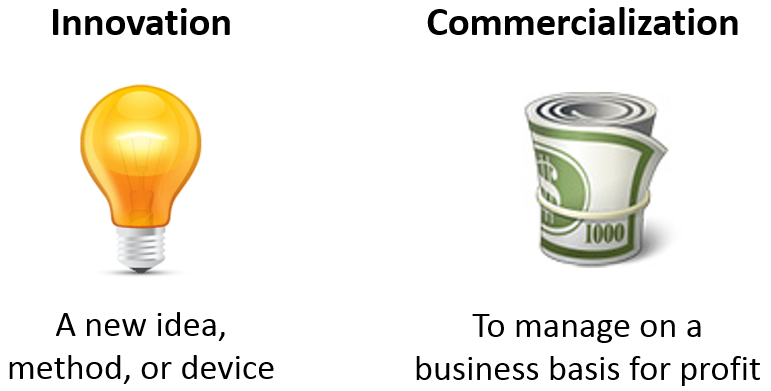
February 8, 2019
Commercialization: The Business Side of Innovation
3 minute read
The business landscape is littered with great ideas and innovations that didn’t “make it.” Why is this? Why do some innovations go on to be market-changing new products while others remain nothing more than a novel idea?
Design Profitability into the Business Plan
Let’s step back a second and start with how the market decides: the successful innovation creates value. While “value” can be a bit nebulous and may differ depending upon the world-view in which it is being discussed, in the business world, value is simply profits. The innovations that make money are the ones that last, and the ones that don’t, or don’t have a plan to, get lost.
And that’s why we encourage innovation teams to think both about the idea AND the commercialization. The dictionary defines commercialize as “to manage on a business basis for profit” and this is the side of innovation that too often gets lost behind the excitement of the “new idea, method, or device.” Unfortunately, when it does get lost, teams miss the opportunity to “build in” commercialization thinking early in the process when seemingly harmless choices on how to build the business get made that ultimately make it difficult to “manage for profit.”
The Broccoli Dilemma
For example, an over-the-counter medicine company was looking to expand a key brand into the nutritional space with an innovation that could deliver a great-tasting kid’s snack bar with the health benefits of a vegetable. Through research, moms said the vegetable they most wanted their kids to get more of was broccoli, so the brand team created a broccoli concept with strong appeal and R&D focused resources on formulating with broccoli.
After millions of dollars in development (not including people’s time), the contract manufacturer finalized pricing and everyone was shocked to learn that the best case scenario COGS was double what they had expected, effectively stripping all profitability out of the project. The company’s blinder was their experience that raw material costs rarely fluctuate in medicines and they missed the fact that when this initiative was scaled-up to meet projected market demand, this would nearly double the demand for broccoli in the U.S., which would profoundly impact its cost.
Long story short, because they had already invested millions of dollars behind an exciting “new idea” without fully understanding how to “build a business for profit,” management no longer had the stomach to provide the subsequent funding the team would need to “pivot” to a new concept with higher pricing or a new concept with a different – less expensive – formulation. And, as a result, the project was put on the shelf.
Key Points:
- Ideas are exciting to work on and can grab more than their fair share of attention, so ensure teams put resources against both the innovation side of the business AND the equally important commercialization side of the business.
- Allocating resources to design profitability into the business approach from the start will enable teams to avoid “dead-end” paths where the potential profitability of a business doesn’t justify further investment.
- Building an innovative and profitable business requires understanding how key choices on interconnected building blocks (e.g. concept, product, pricing, sales channels, marketing approach, COGS structure, etc.) impact profitability.


